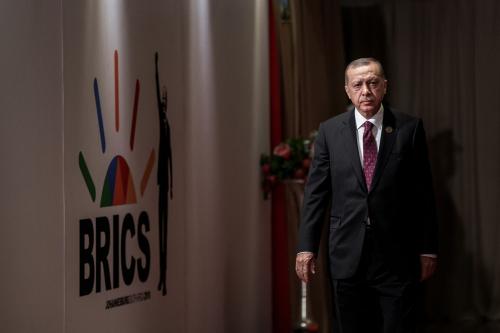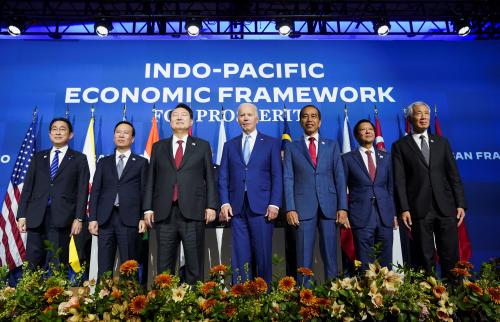Localization, putting local stakeholders rather than donors in the driver’s seat of development, is becoming the accepted mode of development, at least in theory, if not in practice. As one of the least understood elements of localization is the role of international actors, in April 2024, the Brookings Center for Sustainable Development hosted a roundtable to seek to define that role—or roles—better. As there are differing views and to share the breadth of the roundtable discussion and continue the dialogue, on September 9, I published the original framing essay for the roundtable along with a series of 16 “viewpoints” by participants in the discussion.
This commentary enumerates the key themes of those essays and identifies elements that need further elaboration.
Premise of localization
Many of the essays touch on the fundamental premise of localization, a lesson that the U.S. business community learned decades ago, that decisions best rest with those closest to the client as that is where knowledge of client priorities and needs resides—often articulated as shifting power to put local organizations in the driver’s seat. This premise fundamentally challenges the traditional approach of donors, still prevalent today, of decisions being made in the home capital and by international implementers rather than local stakeholders. One essay notes that while local leaders generally know what is best, that is not always the case.
Collectively, the essays are grounded in the two rationales for localization: one based on morality, arguing that local ownership is the fair and equitable approach to development, and the other based on practicality, asserting that local ownership produces better development outcomes. Various essays call for moving from a relationship that is often characterized as colonial to a shift of power from Northern to Southern entities. They also collectively call for the North/South relationship to be characterized by equity, inclusion, respect, and trust.
Approaches
Some of the essays present the models that the authors’ organizations and others use to institutionalize localization. This includes the essays by senior staff from the U.S Agency for International Development (USAID) and the Millennium Challenge Corporation (MCC) and of implementing organizations, both Northern and Southern. Some focus on the nature of the relationship with local organizations, and others focus on how transnational connections support local stakeholders.
Definition of Local
A number of the essays address the definition of “local.” Several assert that international entities are instrumentalizing localization by nationalizing their country offices and decentralizing power to local entities. They argue that affiliates and subsidiaries of international non-government organizations (INGOs) should not be considered local and that the appropriate definition should be determined by local stakeholders. Several of the essays note the difference in definition between that used by USAID in its 2022 and 2023 localization progress reports and the research by Publish What You Fund and Oxfam. Another issue is inconsistent use of the term “local”—some use it in reference to national level entities and others to groups at the community level.
Role of USAID and other donors
Collectively the essays identify a range of actions USAID has taken to implement localization. These include the two goals of directing 25% of funding to local organizations by 2025 and ensuring 50% of funding places local communities in the lead in setting priorities, designing, and implementing programs by 2030. Other initiatives include the New Partnership Initiative, co-creation, procurement restricted to local entities, transition awards, increased audit thresholds and per diems, Toolbox for Empowerment, Work with USAID, Locally Led Program Indicators, and issuing documents in languages other than English.
While recognizing USAID’s considerable efforts and progress on transitioning to locally led development, multiple essays make recommendations on how USAID and other donors can further progress. These recommendations include expanding transition awards and capacity strengthening, tightening the definition of local actor, simplifying complex and onerous procurement processes and compliance requirements, providing flexible and multi-year funding, allowing local organizations to make mistakes (an important source of learning), not requiring local organizations to compete with Northern organizations, scaling up localization, and adopting the IASC (Inter-agency Standing Committee) definition of local and national non-state actor.
Several authors suggest what could be a powerful approach of donors pushing implementing organizations to rethink their business model by requiring them to operate in a localization mode to serve as an instrument of localization.
Role of international actors
There appears to be general agreement on the overall issue posed at the roundtable and the framing essay that there is a role for international actors. There is no interest from local stakeholders in INGOs disappearing. What is sought is a relationship based on equity and trust. There is no one-size-fits-all approach; rather, the relevant approach will vary according to sector, geographic location, and capabilities of the local organization. The roles international actors can play will evolve as part of a transitioning process.
The nine roles (interpreter, knowledge broker, trainer, convenor, connector, advocate, watchdog, critical friend, and sidekick) laid out in a report by Peace Direct captures many of the roles covered by various essays. Additional roles referenced include performing as a backbone organization, intermediary, or network; listening to local actors; serving as an ally (including in dispelling the myths of corruption and lack of capacity) and advocate; moving action to scale. While some essays accept the role of INGOs as intermediaries, others emphasize the need for a partner-based relationship.
Further elaboration
Various essays mention that a relationship of trust is sought but provide no specifics on what that entails and how it can be achieved. Similarly, while the objective of an equitable relationship is often cited, there is little discussion on what that would look like and how to overcome the fundamental dynamic that “he who holds the purse has the power,” along with the necessary accountability to home country congress and parliament. The same goes for the concepts of relations based on humility and mutuality. Too often, these terms are met with a head nod of acceptance but without an understanding of what such relationships entail and how they are built.
What’s missing
Only one of the essays notes that international actors are not “neutral.” None mention that international actors are, by definition, political actors. Not discussed is how international implementers do or should relate to the political environment. They can be positive actors by bridging political divides and conflicts, supporting and even protecting good development actors, and serving as independent actors performing analysis and convening. But they can also play a negative role, such as when they align with entrenched elites.
A suggestion that is made in the framing essay but not addressed in any of the ensuing essays is the potential role of grants in executing localization. USAID provides funding to implementing organizations principally through contracts and cooperative agreements. These funding mechanisms are accompanied by extensive, detailed conditions that require considerable expenditure of human and financial resources and building staff capabilities that often are irrelevant to the basic purpose and activities of the recipient organization. USAID provides funding to official international organizations as grants, and, historically, USAID functioned generally more through grants. The significance is that grants have much fewer conditions and requirements, with the basic concept being to support an organization in its existing mission and programs. Grants would seem fundamental to representing the mechanism of locally led development—supporting local priorities, design, and implementation.
Conclusion
One essay (Hofmann) articulated explicitly what is inherent in many of the essays, that localization should not be seen as local versus international, but as networked, transnational development, especially given the ever-growing need for global connections and learning.
USAID has set ambitious goals of directing 25% of funding to local organizations by 2025 and achieving 50% fully driven by local ownership by 2030—the end date for the Sustainable Development Goals. The agency is unlikely to meet the 2025 goals, but hopefully, the experience and lessons of the past decade can be translated into meeting the 2030 objective of local stakeholders setting priorities, design, and implementation.





Commentary
Locally led and globally informed: Key themes on localization
September 20, 2024